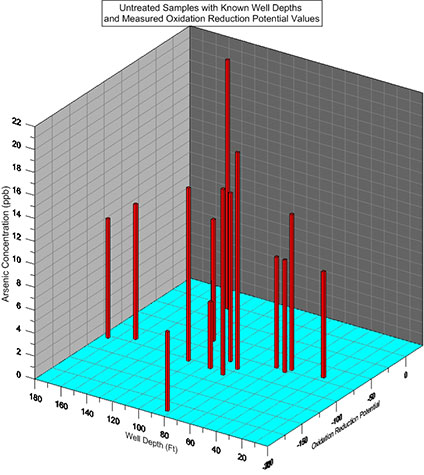ORP Sampling Determines Arsenic in Wells
Arsenic is one of the most common elements in the earth’s crust and is commonly found in many locations at varying concentrations. The Midwestern United States has locations that are heavily laden with arsenic because of certain geological settings and conditions. This naturally occurring arsenic can leach into groundwater potentially causing elevated levels of arsenic in drinking water supplies. The primary pathway that exposes arsenic to humans is through drinking water (Thomas et. al., 2008). 
Arsenic has a number of detrimental health effects when consumed at both short-term high doses and long-term low doses. Chronic, low dose exposure is the most common and may cause skin damage, digestive problems, cardiovascular, pulmonary, immunological, neurological, reproductive, and endocrine problems. Arsenic exposure is also linked to cancers of the bladder, lungs, skin, kidney, nasal passages, liver, and prostate. (USEPA, 2010)
Because of the detrimental health effects of arsenic the United States Environmental Protection Agency (USEPA) requires that public water systems provide water to consumers with a maximum contaminant level (MCL) of 10 ppb arsenic. Public water systems use either a groundwater source or a surface water source, including groundwater under the direct influence of surface water.
Private water systems are households and small businesses that serve fewer than 25 people per day 60 days out of the year. Private water systems are regulated by the Ohio Department of Health but there is no regulation related to arsenic in private water systems. Private well owners are responsible for ensuring their own water is safe for consumption.
Previous investigations of the occurrence of arsenic in groundwater in the Great Miami River Watershed focused on the geochemical conditions which allow for arsenic dissolution. These investigations are limited to collecting samples from just a few specific sites (Dumouchelle, 1998; Thomas et. al., 2008; Thomas, Schuman, and Pletsch, 2005). The number of samples analyzed and the geographic distribution of the sampling sites are insufficient to provide a characterization of baseline arsenic concentrations across the entire watershed.
Miami Conservancy District (MCD) staff recognized that to have a better understanding of how frequently, and at what levels, arsenic occurs in private water systems in the Great Miami River Watershed more wells needed to be sampled.
The objective of this study is to collect baseline data that provides a better understanding of the number of private water systems that have elevated levels of arsenic in the Great Miami River Watershed. The YSI Professional Plus (now ProQuatro) multiparameter water quality handheld was used throughout the study for oxidation reduction potential (ORP) measurements.
This study was designed to sample private water systems that represent the geographic boundaries of the Great Miami River Watershed.
To locate wells for inclusion in the study, MCD staff recruited private water system owners who attended a local Test Your Well event. Test Your Well is a program developed by the Groundwater Foundation and locally sponsored by MCD. At the events, private water system owners were given the opportunity to sign up for arsenic testing. To ensure a broad geographic representation of the watershed, the locations of the wells were placed on a map.
MCD’s well database was then searched for additional possible sampling locations and those private water system owners were also invited to participate. Sample collection dates and times were set up at the well owner’s convenience. The private water systems included in this study were located in eleven counties, Hamilton, Butler, Warren, Montgomery, Preble, Miami, Shelby, Logan, Champaign, Clark, and Greene, in the Great Miami River Watershed.
Historical information on each well that was chosen for sampling was also gathered from the Ohio Department of Natural Resources Division of Water well logs if available. Well logs include information on construction and geology. Not every well in Ohio has a well log. When the laboratory reported the sampling results to MCD staff, those results were collected in a database. Individual results were also reported back to the well owners. Well owners were given information about the health effects from consuming arsenic, treatment options, and who to contact for more information.
(Full-length application note available)


Additional Blog Posts of Interest:
Biological Nutrient Removal Applications for Monitoring ORP
Advanced Groundwater Monitoring At National Corvette Museum Sinkhole
Monitoring Climate and Water Quality Dynamics in Agro-Ecosystems
ORP Management in Wastewater as an Indicator of Process Efficiency